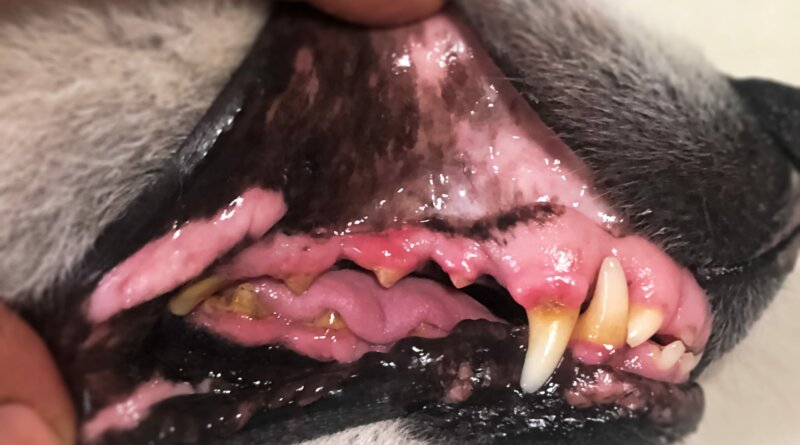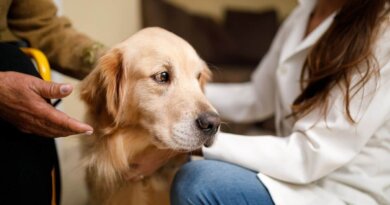Periodontal Diseases In Dogs : Symptoms, Stages and Prevention
Recent studies have reported that about 90% of dogs develop periodontal disease by the age of two.
Therefore, periodontal, or in other words, gum disease, is one of the most common health issues among our canine companions.
And chances are, your dog has fallen victim to this health threat.
But what is periodontal disease, and how does it affect your dog?
In this article, we will discuss:
- What is periodontal disease, and what causes it among dogs
- What are the signs and stages of periodontal disease in dogs
- How can you prevent it, and how much would the treatment cost you
So, if you’re looking for signs of gum disease or prevention ideas, you’ll find today’s article beneficial.
So, let’s dive right in!
What is Periodontal Disease in Dogs?
Periodontal disease is a progressive, recurring, inflammatory gum issue usually caused by oral bacteria.
This leads to an infection that occurs in the tissues that hold the dog’s teeth.
Since it hides below the gums, most homeowners rarely notice this at first. And if they do, it’s usually at a severe stage.
By then, your dog may be suffering from chronic pain already.
That is why implementing preventive dental care at an early age is essential to save your dog from this horrible infection.
Is Periodontal Disease in Dogs Contagious?
Periodontal disease in dogs is not contagious to other pets and humans.
But just like dogs, all people are at risk of suffering from the same health issue if you would not observe proper dental care.
Is There Any Vaccine for Periodontal Disease?
Sadly, there is no vaccine available to prevent this gum disease, but there are some ways you can do to keep your dog’s gums healthy.
Causes of Periodontal Diseases in Dogs
Dogs are more prone to gum diseases because they have more alkaline in their mouth, ideal for plaque-forming bacteria.
And as mentioned above, the main culprit in periodontal disease is the oral bacteria that sticks into your dog’s teeth in the form of plaque.
This sticky white substance that coats the teeth is a biofilm material composed of many microorganisms.
It will form within 24 hours if left uncleaned and not brushed daily.
And after 72 hours, it will be mineralized, harden and turn into a dental calculus called tartar that is more difficult to remove.
Studies show that plaque and tartar carry billions of bacteria per gram. This figure only shows how important, regular brushing is in preventing them from building up.
What Breeds Are the Most Susceptible to Periodontal Disease?
Aside from poor dental hygiene, a dog’s genetic, breed, jaw, and mouth shape can make it more prone to gum diseases.
These are the dog breeds that are at higher risk of developing periodontal diseases.
Pugs
Sadly, these wrinkly but flat-faced cuties are prone to health problems due to their tiny jaws that cause teeth crowding.
Crowding makes them more susceptible to plaque buildup, leading to gingivitis and more severe problems such as periodontitis and teeth loss.
Other short-muzzled dog breeds face a similar issue, including English bulldogs, Chihuahuas, Dachshunds, Shih Tzus, and Boston Terriers.
Collies
These herding dogs with pointed snouts have an overbite, which makes them susceptible to gum diseases.
Yorkies
Small and toy breeds with deciduous teeth like Yorkies, Poodles, Maltese, and Pomeranians easily collect food and debris in hard-to-reach areas, predisposing them to periodontal diseases.
Shih Tzus
Teeth crowding is not the only dental issue about this well-loved breed because its teeth may also erupt from the gums later than usual.
And in worse cases, it can lead to tooth impaction and the formation of dentigerous cyst.
Signs and Stages of Periodontal Disease in Dogs
Stage 0. Normal and Healthy Periodontium
Pink and non-inflamed gums may indicate that it is healthy and normal. There is no pocket, and lamina dura or compact bones are uninterrupted at this stage.
Stage 1. Gingivitis
There will be inflammation in the gums at this stage due to plaque deposition and lack of dental care with no loss of bone or tooth attachment.
Symptoms:
These signs may indicate your dog has gingivitis:
- Plaque and tartar deposit on the tooth
- mild redness or inflammation of gums
- Gums bleed during brushing and chewing
- Bad breath
Prognosis: Stage 1 or gingivitis is reversible with diligent dental care or professional scaling and polishing. But it can lead to stage 2 if no treatment is applied and bacteria increases.
Stage 2. Early Attachment Loss
It occurs when periodontal pockets emerge between the gum and tooth, and about 25% of the tooth’s support is lost. Mild bone loss may be visible on x-rays at this stage.
Symptoms:
Stage 2 symptoms include:
- Pocket forms
- Red or puffy gums
- Gums bleed
- Bad breath
- Receded gums and bone
Prognosis: Proper dental care is crucial in this stage to prevent further complications. Gum tissues may need cleansing, rinsing, and treatment with gel to reattach the gum back to the root.
Stage 3. Moderate Attachment Loss
Attachment loss in stage 3 may increase from 25 up to 50%, and X-rays would also show severe bone loss since the pockets have gone deeper up to 5 mm.
Symptoms:
Stage 3 symptoms include the following:
- Plaque and tartar extend further down the root
- Deepening pocket
- Moderate gum recession
- More extensive bone reduction
- Loose teeth
Prognosis: Advanced dental procedures are necessary for this stage.
Stage 4. Periodontitis
This stage is now known as periodontitis, where around 50- 70% of the tooth’s attachments are lost.
Symptoms:
Symptoms of severe periodontitis include:
- Extensive plaque and tartar (calculus)
- Severe inflammation
- Pocket deepening
- Painful bone and gum loss
- Tooth root exposure
- Loose or missing teeth
- Pus arising from around the teeth
Prognosis: Tooth extraction is the only treatment for affected teeth in this stage.
Is Periodontal Disease Reversible in Dogs?
As shown above, only the first stage (gingivitis) of periodontal disease is reversible because it only involves unpleasing breath and inflammation.
At this level, the supporting structures of the teeth are free from damage. On the other hand, stages 2 and 3 require proper dental treatment to prevent it from developing into periodontitis.
Is the Periodontal Disease in Dogs Painful?
Gingivitis (Stage 1) and periodontitis (Stage 4) that may come with oral lacerations, broken teeth, jaw fractures, and oral cancer are painful conditions.
These may cause severe discomfort among affected dogs and behavioral changes, such as the following:
- It can no longer bear getting their teeth brushed due to painful gums
- It starts chewing differently or smacking their gums
- Flinch or pull away when you try to lift their lips to look at their teeth
- It may become more withdrawn or aggressive
- Your dog may become hesitant to play with chew toys.
Treatments for Periodontal Disease in Dogs
Treatments will vary depending on how severe the disease is. These are the typical steps vets would take for every stage.
Treatment for Stage 1 (Gingivitis):
Aside from home dental care, dogs with gingivitis need a thorough dental cleaning performed by vets, which involves the following procedures:
- Removal of plaque and tartar by scaling the teeth above and below the gum line and making sure it’s well-polished.
- Conducting full mouth X-rays to confirm the stage of advancement of the disease and ensuring there’s no bone loss.
- Examining each tooth to determine if there exists an abnormal pocketing.
Since it can be tricky for vets to do the steps mentioned above, general anesthesia is often necessary for those procedures.
Treatment for Stage 2:
Professional teeth cleaning is still a must at this stage.
But, the only visible symptom is the swollen gums, so vets utilize X-ray machines to see through the bone.
They’ll also need to deep clean abnormal periodontal pockets and close those areas with antibiotic gel, preventing the disease from progressing.
Some vets may also recommend giving your four-legged companion some special toy they can tug to help remove the plaque besides brushing time.
Others may suggest as well to include veggies in your dog’s diet since they can help.
Treatment for Stage 3:
At this point, operations like opening a gum flap and cleaning out damaged tissue around the tooth or bone may be necessary.
Experts also use special therapies to grow the new tissue and bone. Otherwise, they may have to extract the decayed teeth.
Treatment for Stage 4 (Periodontitis):
There’s no other way to save your dog from periodontitis aside from removing all the damaged teeth. It is too dangerous to keep them, but it also comes at a cost.
You’ll have to invest time and money in figuring out and making sure your puppy can eat his food even with little to no teeth.
What Will Happen If You Will Not Treat Periodontal Disease in Your Dogs?
Untreated severe periodontitis may result in destructive health issues in your dog’s body, such as:
Pathological Jaw Fractures
Gum disease can also lead to jaw fracture since it destroys the bone that supports the teeth.
And because toy breeds’ teeth are close to the edge of their jawbones, they’re most likely to suffer from this condition.
Tooth Abscesses
The bacterial infection in the tissue also paves the way for the growth of a periodontal abscess – a pocket of pus characterized by thick, yellowish liquid.
It can burst out of the skin and may even create awful open wounds in your pet’s chin or cheeks.
Oronasal Fistulas
These nasty holes that go through the mouth and nasal passages are common among Dachmunds.
An untreated gum infection causes it. If your dog constantly sneezes and produces nasal discharge, look out for that is a red flag.
Eye Issues
The dog’s teeth are located behind the mouth and underneath the eyes. So, the infection can also affect its eyes. And if you’ll not be able to get it treated, the worst-case scenario is your pet may lose its eyesight.
Oral Cancers
Chronic gum diseases may also put your dogs at a higher risk of getting oral cancer.
Prone to Organ Damage
Bacteria and inflammatory compounds along the gums can also enter the bloodstream and spread to other parts or organs of your pup’s body.
So, if your dog is suffering from gum disease, he’s also at a higher risk of having a chronic disease in its heart, liver, and kidney.
Treatment Cost for Periodontal Diseases in Dogs
On average, dental cleaning costs for dogs can range between $450 and $1,000 depending on the geographical area, type of procedure performed, and the time it takes to complete it.
Oral radiographs, which cost around $150-$200, are not included in that pricing.
Cleaning and extracting performed by veterinary dental specialists are even more expensive due to X-rays and anesthesia needed for the treatment.
It can range from $2,000 to as much as $3,000.
Therefore, dental care for dogs can be as expensive as it is for humans.
How to Prevent Periodontal Diseases in Dogs?
Here are some prevention tips you can take to help reduce the chances of your dog getting periodontal disease.
Brush your dog’s teeth regularly.
One of the best ways to prevent plaque from building up is regular brushing with animal-safe toothpaste, ideally two times a day.
Brushing needs to be started as soon as your pup’s adult teeth show up, and that is around six months of age.
Please take note that you should avoid brushing your dog’s teeth while it’s teething because that can be painful and cause trauma and fear of brushing.
And just as we humans need to make brushing part of our daily routine, dogs too need their teeth to be cleaned consistently. Only then will brushing become effective.
But, this may not be possible for all owners and pets.
Good thing, there are tooth care products that can be an alternative to brushing.
Alternatives to brushing:
Textured dental wipes can help remove plaque and tartar that are on the surface of the tooth.
But, they’re not as effective as toothbrushes in cleaning nooks and crannies of the teeth, especially the gingival sulcus where the teeth and gums meet.
- Oral rinses or dog mouth wash
Antibacterial mouth wash or oral rinse products can eliminate the leading cause of periodontal disease, the bacteria that sit in plaques and tartar.
They can also help eliminate bad breath and make the dog feel fresh.
Dental toys and treats are designed to clean dog’s teeth as they chew on them. They help the pup’s teeth become stronger and satisfy their innate desire to chew.
Dental chews also come with enzymes that aid in removing plaque and tartar buildup from the teeth and gums.
Gentle reminder: Never use human toothpaste because it usually contains fluoride that is poisonous for dogs. And kindly consult your vets for brushing instruction.
Make sure your dog’s diet is healthy.
As we all know, sugary foods can cause bacteria to build upon their teeth. So, it would be best not to give your fido too many sweets.
Veterinarians and dog owners believe that a diet of raw meaty bones is beneficial for dogs’ oral health.
They contain natural enzymes that prevent bacterial plaque and induce active chewing. Thus, helping the gums stay clean and healthy.
Attend dental checks and cleaning regularly
As a fur parent, you also need to ensure your fido receives preventive dental cleaning under anesthesia and undergoes check-up regularly.
As recommended by AAHA or American Animal Hospital Association, you must bring your pup to a specialist for a dental cleaning as early as one year of age if it’s a small and toy breed, and two years of age if it belongs to large breeds.
But if your doggo shows signs of gum disease at an age younger than previously mentioned, then you must do the dental cleaning immediately.
The cleaning’s frequency depends on different factors, including your pup’s breed and the stage of the disease, and how frequently you brush its teeth in your home.
How Long Can A Dog with the Periodontal Disease Live?
Gum diseases don’t just affect your dog’s health and behavior but also its lifespan. If left untreated, it can take two years or more of your canine’s life.
Not to mention the pain it would have to go through every single day. So, this condition isn’t something you should downplay because it comes with a cost.
How Long Does It Take for Dogs to Recover from Periodontal Disease?
The recovery time of dogs with gum disease varies depending on the severity and treatment needed.
If a dog goes through cleaning and scaling, he should be fine the next day. However, anesthesia recovery time may vary.
In worse stages where specialists need to extract the damaged teeth, it takes a week for the extraction site to heal.
Your fido may become sensitive at that time, but he’ll be fine after the day of the surgery.
For dogs with Stage 3 and 4 gum disease, it will take some time to heal.
They need pain and anti-inflammatory medication and antibiotics, so they need the full attention of their owner, making sure they’ll receive their treatment daily and visit vets for follow-up check-ups.
Final Thoughts
Periodontal disease is common among canines, but it’s 100% preventable.
With proper and regular dental care along with a balanced diet and regular visits with vets, your dog can beat and prevent periodontal disease and live an active and happy life.
It may require daily commitment, but having a healthy, happy, and active dog free from gum disease can be very rewarding.
READ NEXT: Pale Gums in Dogs: What It Means and What to Do









